FORD RANGER 2004 2.G Owners Manual
Manufacturer: FORD, Model Year: 2004, Model line: RANGER, Model: FORD RANGER 2004 2.GPages: 248, PDF Size: 6.16 MB
Page 141 of 248
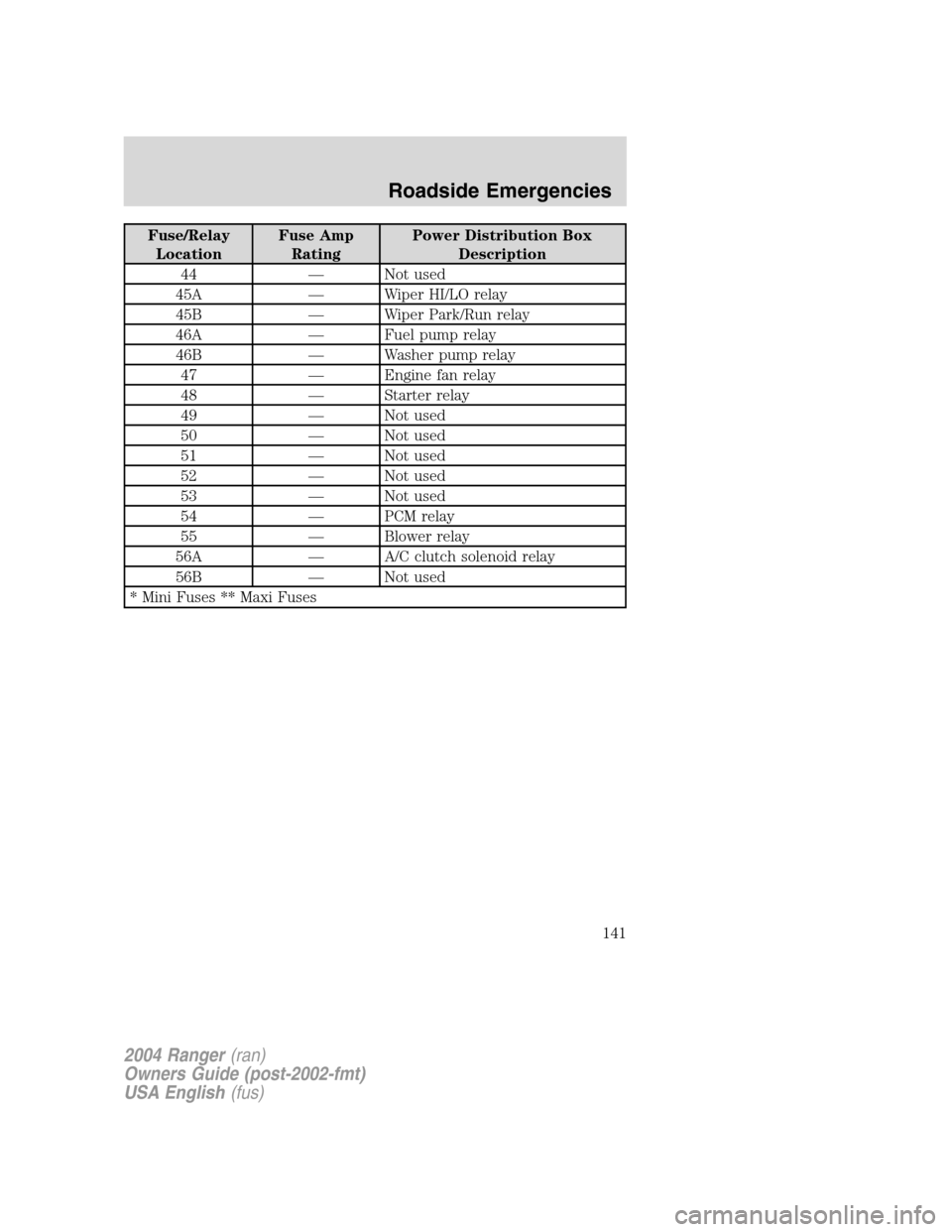
Fuse/RelayLocation Fuse Amp
Rating Power Distribution Box
Description
44 —Not used
45A —Wiper HI/LO relay
45B —Wiper Park/Run relay
46A —Fuel pump relay
46B —Washer pump relay
47 —Engine fan relay
48 —Starter relay
49 —Not used
50 —Not used
51 —Not used
52 —Not used
53 —Not used
54 —PCM relay
55 —Blower relay
56A —A/C clutch solenoid relay
56B —Not used
* Mini Fuses ** Maxi Fuses
2004 Ranger (ran)
Owners Guide (post-2002-fmt)
USA English (fus)
Roadside Emergencies
141
Page 142 of 248
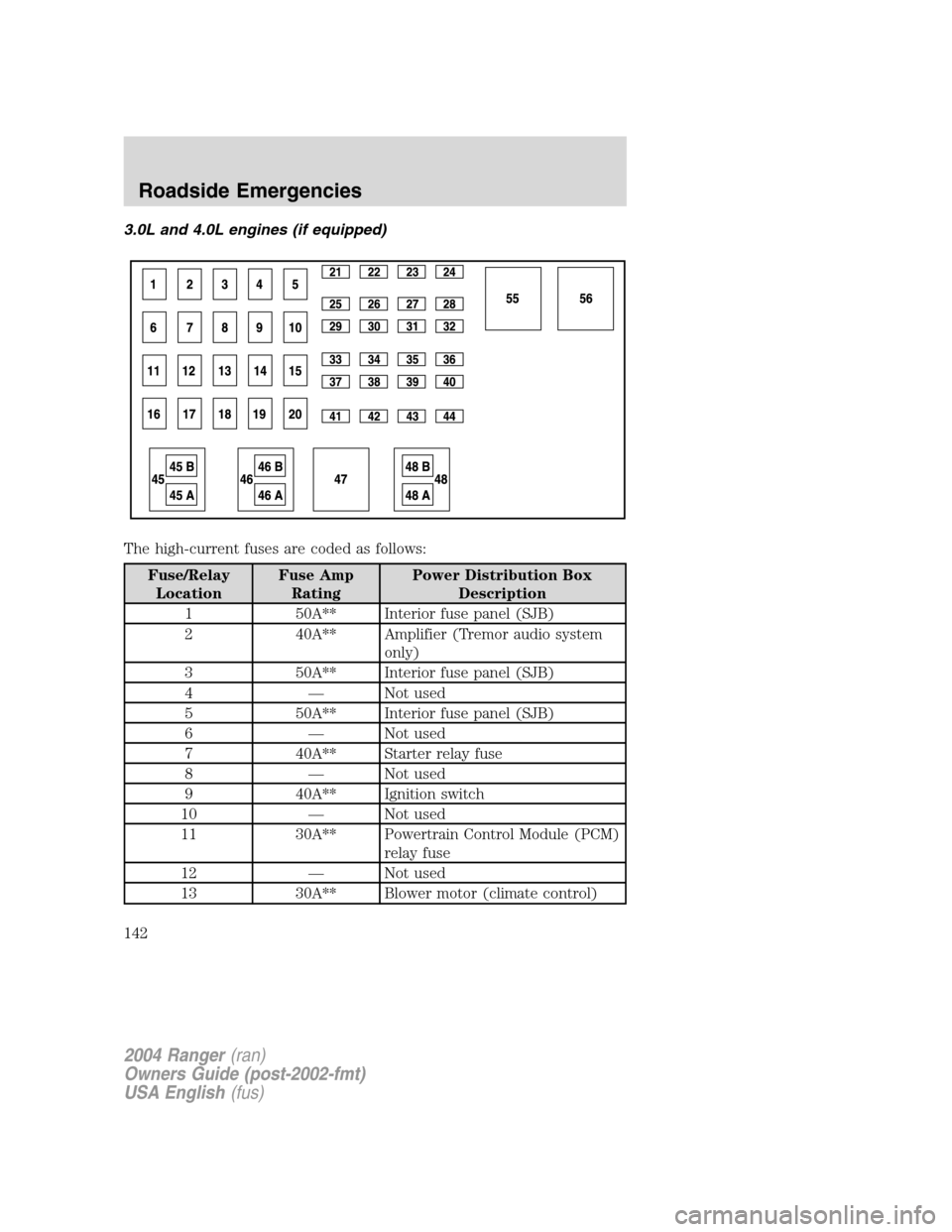
3.0L and 4.0L engines (if equipped)
The high-current fuses are coded as follows:
Fuse/RelayLocation Fuse Amp
Rating Power Distribution Box
Description
1 50A** Interior fuse panel (SJB)
2 40A** Amplifier (Tremor audio system only)
3 50A** Interior fuse panel (SJB)
4 —Not used
5 50A** Interior fuse panel (SJB)
6 —Not used
7 40A** Starter relay fuse
8 —Not used
9 40A** Ignition switch
10 —Not used
11 30A** Powertrain Control Module (PCM) relay fuse
12 —Not used
13 30A** Blower motor (climate control)
2004 Ranger (ran)
Owners Guide (post-2002-fmt)
USA English (fus)
Roadside Emergencies
142
Page 143 of 248

Fuse/RelayLocation Fuse Amp
Rating Power Distribution Box
Description
14 —Not used
15 30A** Anti-lock Brake System (ABS) (solenoids)
16 —Not used
17 40A** ABS (motor)
18 —Not used
19 —Not used
20 —Not used
21 10A* PCM
22 —Not used
23 20A* Fuel pump
24 —Not used
25 10A* A/C clutch solenoid
26 —Not used
27 20A* 4x4 module
28 —Not used
29 —Not used
30 —Not used
31 15A* Foglamps
32 —Not used
33 —Not used
34 —Not used
35 —Not used
36 —Not used
37 —Not used
38 7.5A* Trailer tow (right turn)
39 —Not used
40 —Not used
41 15A* HEGOs
42 7.5A* Trailer tow (left turn)
43 —Not used
2004 Ranger (ran)
Owners Guide (post-2002-fmt)
USA English (fus)
Roadside Emergencies
143
Page 144 of 248
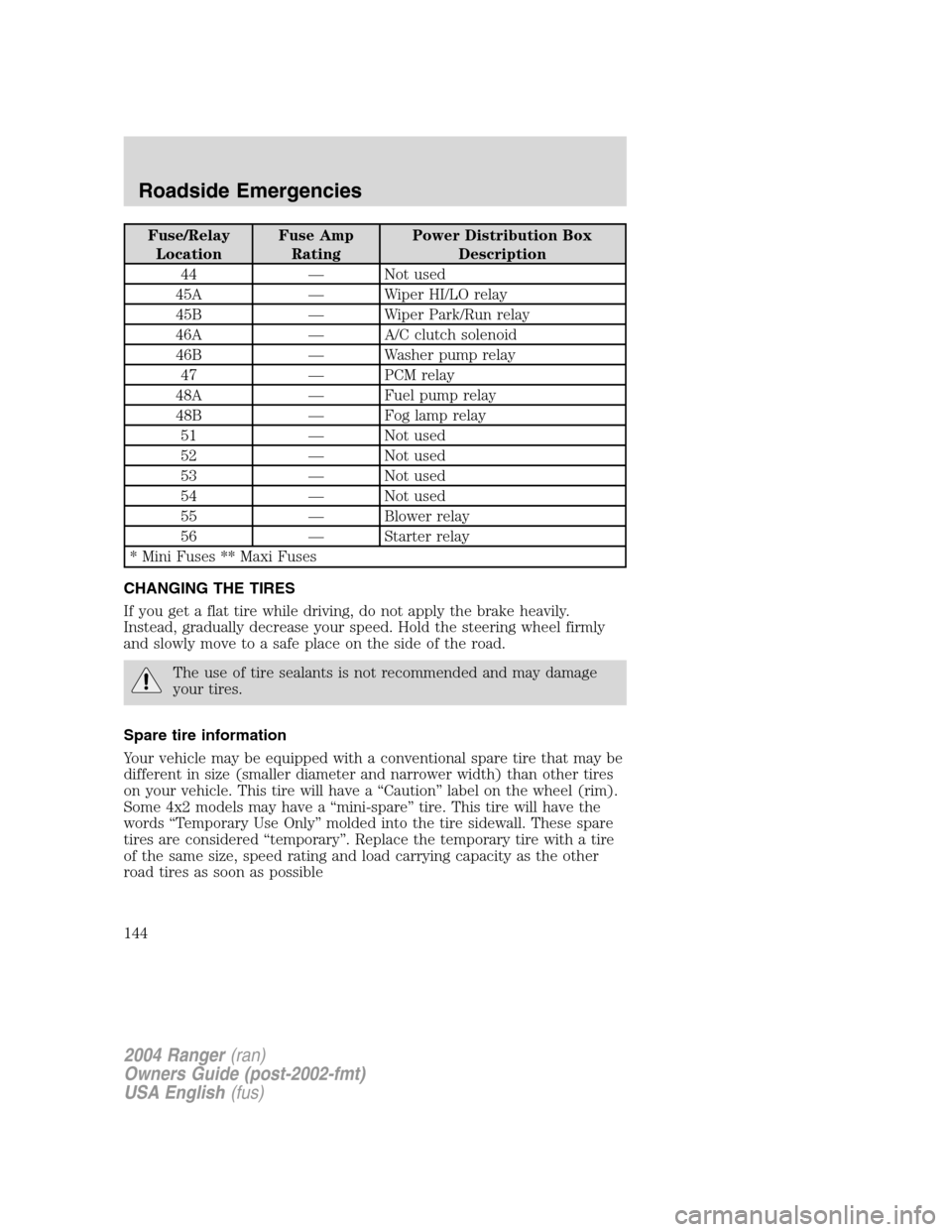
Fuse/RelayLocation Fuse Amp
Rating Power Distribution Box
Description
44 —Not used
45A —Wiper HI/LO relay
45B —Wiper Park/Run relay
46A —A/C clutch solenoid
46B —Washer pump relay
47 —PCM relay
48A —Fuel pump relay
48B —Fog lamp relay
51 —Not used
52 —Not used
53 —Not used
54 —Not used
55 —Blower relay
56 —Starter relay
* Mini Fuses ** Maxi Fuses
CHANGING THE TIRES
If you get a flat tire while driving, do not apply the brake heavily.
Instead, gradually decrease your speed. Hold the steering wheel firmly
and slowly move to a safe place on the side of the road.
The use of tire sealants is not recommended and may damage
your tires.
Spare tire information
Your vehicle may be equipped with a conventional spare tire that may be
different in size (smaller diameter and narrower width) than other tires
on your vehicle. This tire will have a “Caution ”label on the wheel (rim).
Some 4x2 models may have a “mini-spare ”tire. This tire will have the
words “Temporary Use Only ”molded into the tire sidewall. These spare
tires are considered “temporary ”. Replace the temporary tire with a tire
of the same size, speed rating and load carrying capacity as the other
road tires as soon as possible
2004 Ranger (ran)
Owners Guide (post-2002-fmt)
USA English (fus)
Roadside Emergencies
144
Page 145 of 248
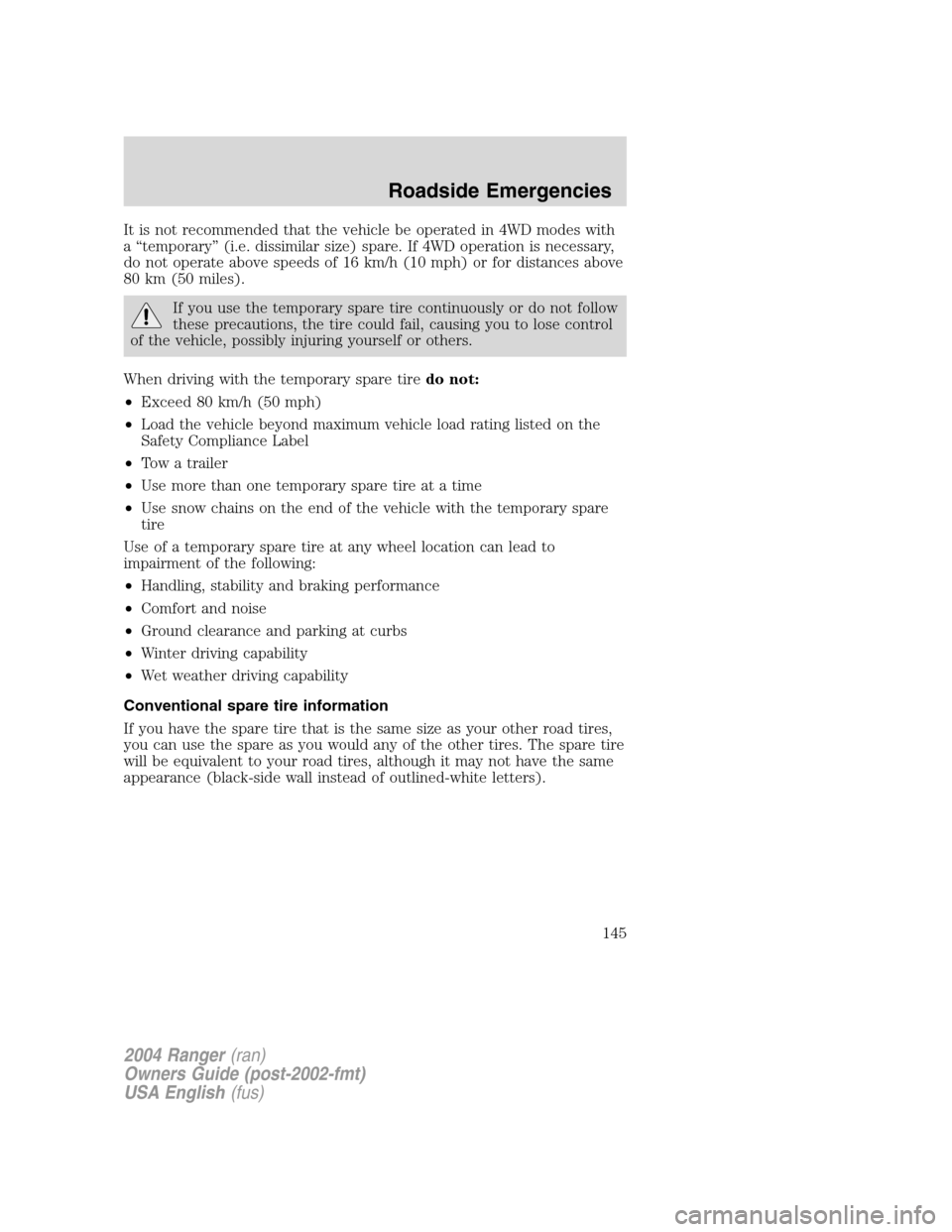
It is not recommended that the vehicle be operated in 4WD modes with
a“temporary ”(i.e. dissimilar size) spare. If 4WD operation is necessary,
do not operate above speeds of 16 km/h (10 mph) or for distances above
80 km (50 miles).
If you use the temporary spare tire continuously or do not follow
these precautions, the tire could fail, causing you to lose control
of the vehicle, possibly injuring yourself or others.
When driving with the temporary spare tire do not:
• Exceed 80 km/h (50 mph)
• Load the vehicle beyond maximum vehicle load rating listed on the
Safety Compliance Label
• Tow a trailer
• Use more than one temporary spare tire at a time
• Use snow chains on the end of the vehicle with the temporary spare
tire
Use of a temporary spare tire at any wheel location can lead to
impairment of the following:
• Handling, stability and braking performance
• Comfort and noise
• Ground clearance and parking at curbs
• Winter driving capability
• Wet weather driving capability
Conventional spare tire information
If you have the spare tire that is the same size as your other road tires,
you can use the spare as you would any of the other tires. The spare tire
will be equivalent to your road tires, although it may not have the same
appearance (black-side wall instead of outlined-white letters).
2004 Ranger (ran)
Owners Guide (post-2002-fmt)
USA English (fus)
Roadside Emergencies
145
Page 146 of 248
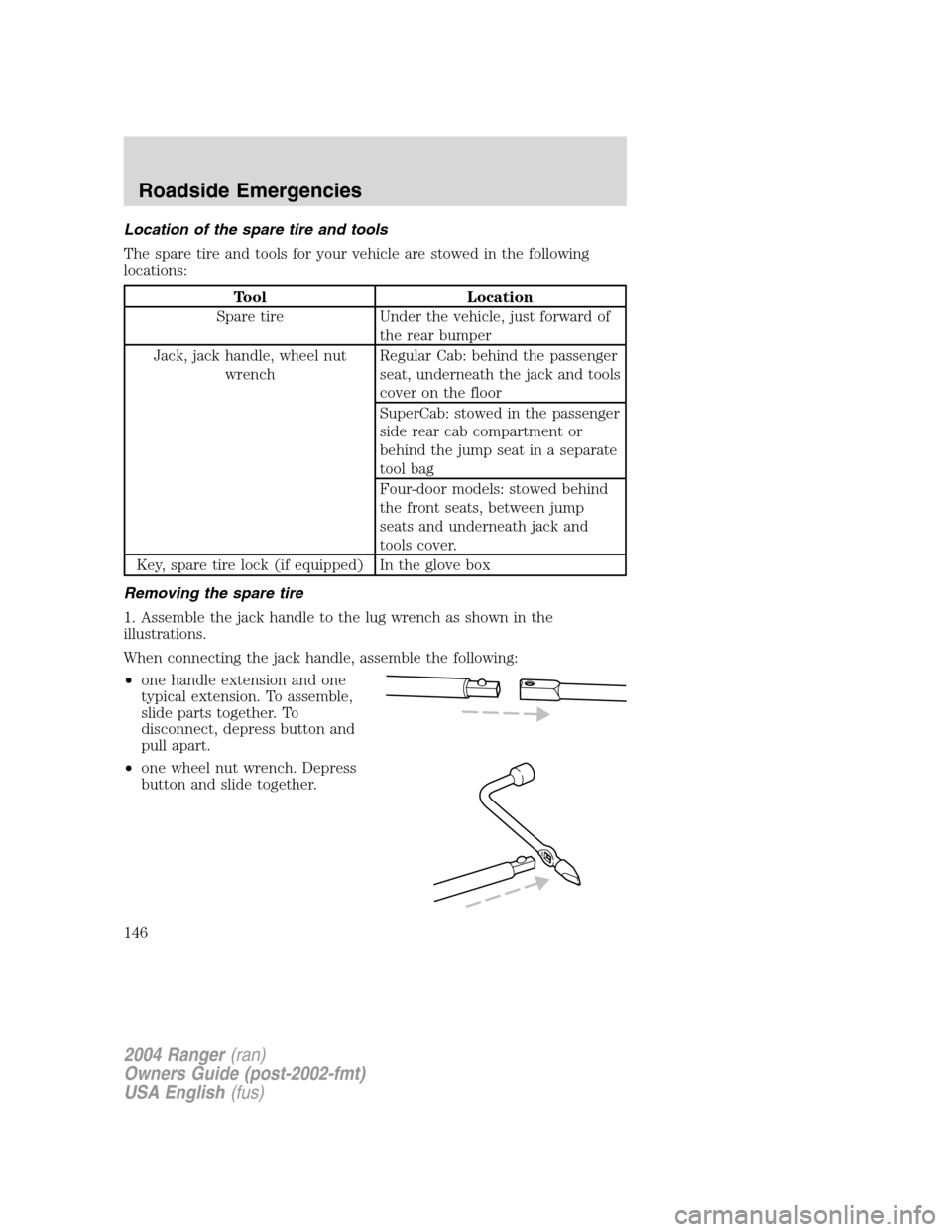
Location of the spare tire and tools
The spare tire and tools for your vehicle are stowed in the following
locations:
Tool Location
Spare tire Under the vehicle, just forward of the rear bumper
Jack, jack handle, wheel nut wrench Regular Cab: behind the passenger
seat, underneath the jack and tools
cover on the floor
SuperCab: stowed in the passenger
side rear cab compartment or
behind the jump seat in a separate
tool bag
Four-door models: stowed behind
the front seats, between jump
seats and underneath jack and
tools cover.
Key, spare tire lock (if equipped) In the glove box
Removing the spare tire
1. Assemble the jack handle to the lug wrench as shown in the
illustrations.
When connecting the jack handle, assemble the following:
• one handle extension and one
typical extension. To assemble,
slide parts together. To
disconnect, depress button and
pull apart.
• one wheel nut wrench. Depress
button and slide together.
2004 Ranger (ran)
Owners Guide (post-2002-fmt)
USA English (fus)
Roadside Emergencies
146
Page 147 of 248
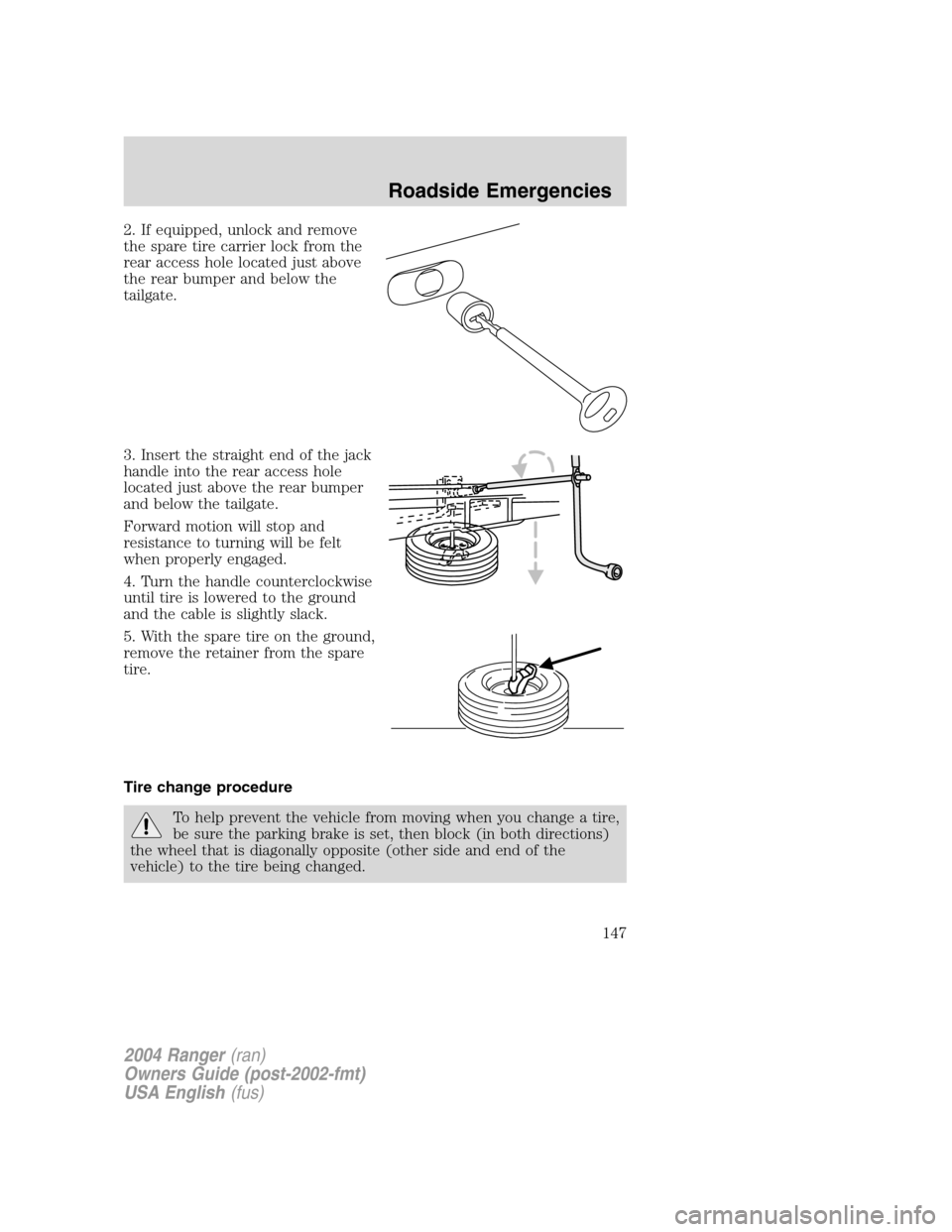
2. If equipped, unlock and remove
the spare tire carrier lock from the
rear access hole located just above
the rear bumper and below the
tailgate.
3. Insert the straight end of the jack
handle into the rear access hole
located just above the rear bumper
and below the tailgate.
Forward motion will stop and
resistance to turning will be felt
when properly engaged.
4. Turn the handle counterclockwise
until tire is lowered to the ground
and the cable is slightly slack.
5. With the spare tire on the ground,
remove the retainer from the spare
tire.
Tire change procedure
To help prevent the vehicle from moving when you change a tire,
be sure the parking brake is set, then block (in both directions)
the wheel that is diagonally opposite (other side and end of the
vehicle) to the tire being changed.
2004 Ranger (ran)
Owners Guide (post-2002-fmt)
USA English (fus)
Roadside Emergencies
147
Page 148 of 248
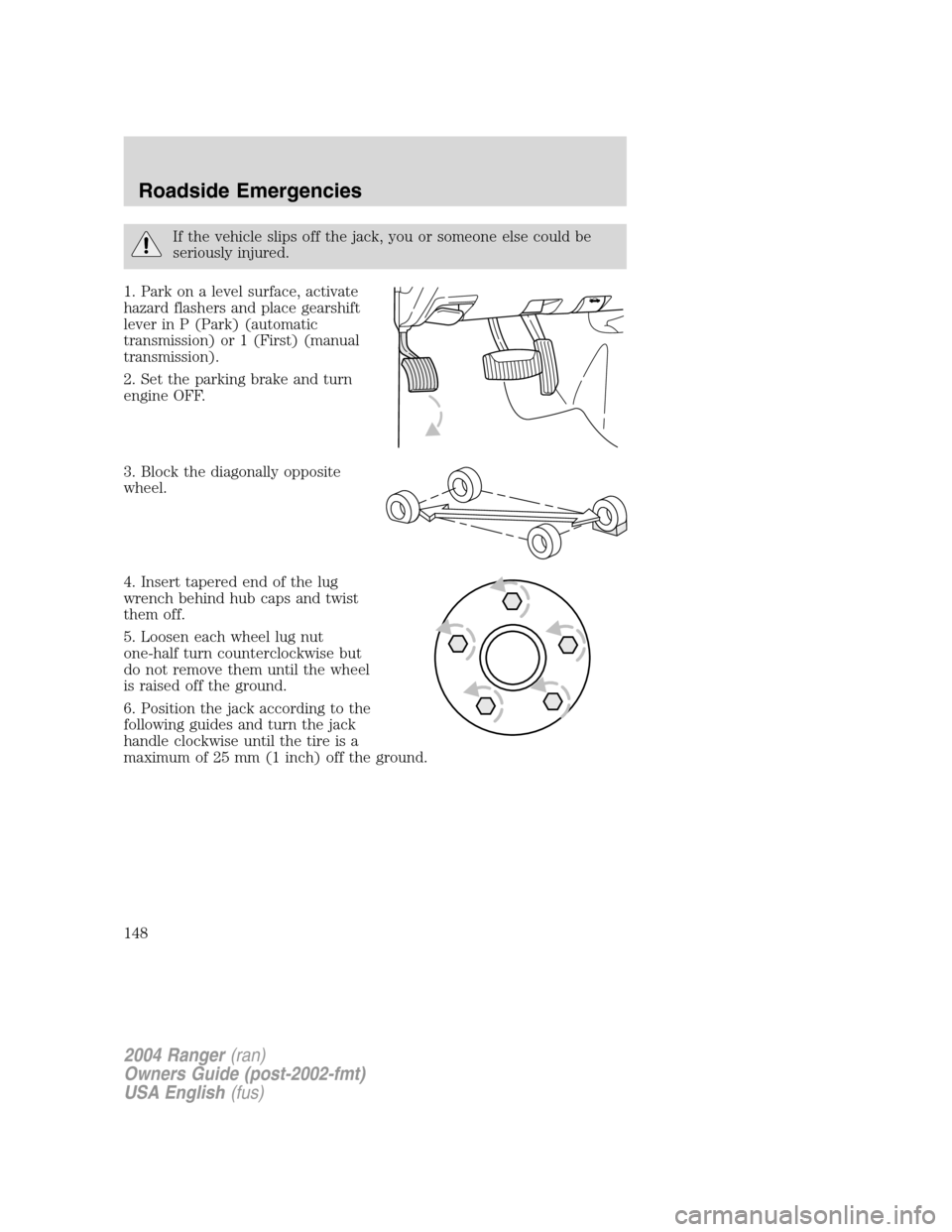
If the vehicle slips off the jack, you or someone else could be
seriously injured.
1. Park on a level surface, activate
hazard flashers and place gearshift
lever in P (Park) (automatic
transmission) or 1 (First) (manual
transmission).
2. Set the parking brake and turn
engine OFF.
3. Block the diagonally opposite
wheel.
4. Insert tapered end of the lug
wrench behind hub caps and twist
them off.
5. Loosen each wheel lug nut
one-half turn counterclockwise but
do not remove them until the wheel
is raised off the ground.
6. Position the jack according to the
following guides and turn the jack
handle clockwise until the tire is a
maximum of 25 mm (1 inch) off the ground.
2004 Ranger (ran)
Owners Guide (post-2002-fmt)
USA English (fus)
Roadside Emergencies
148
Page 149 of 248
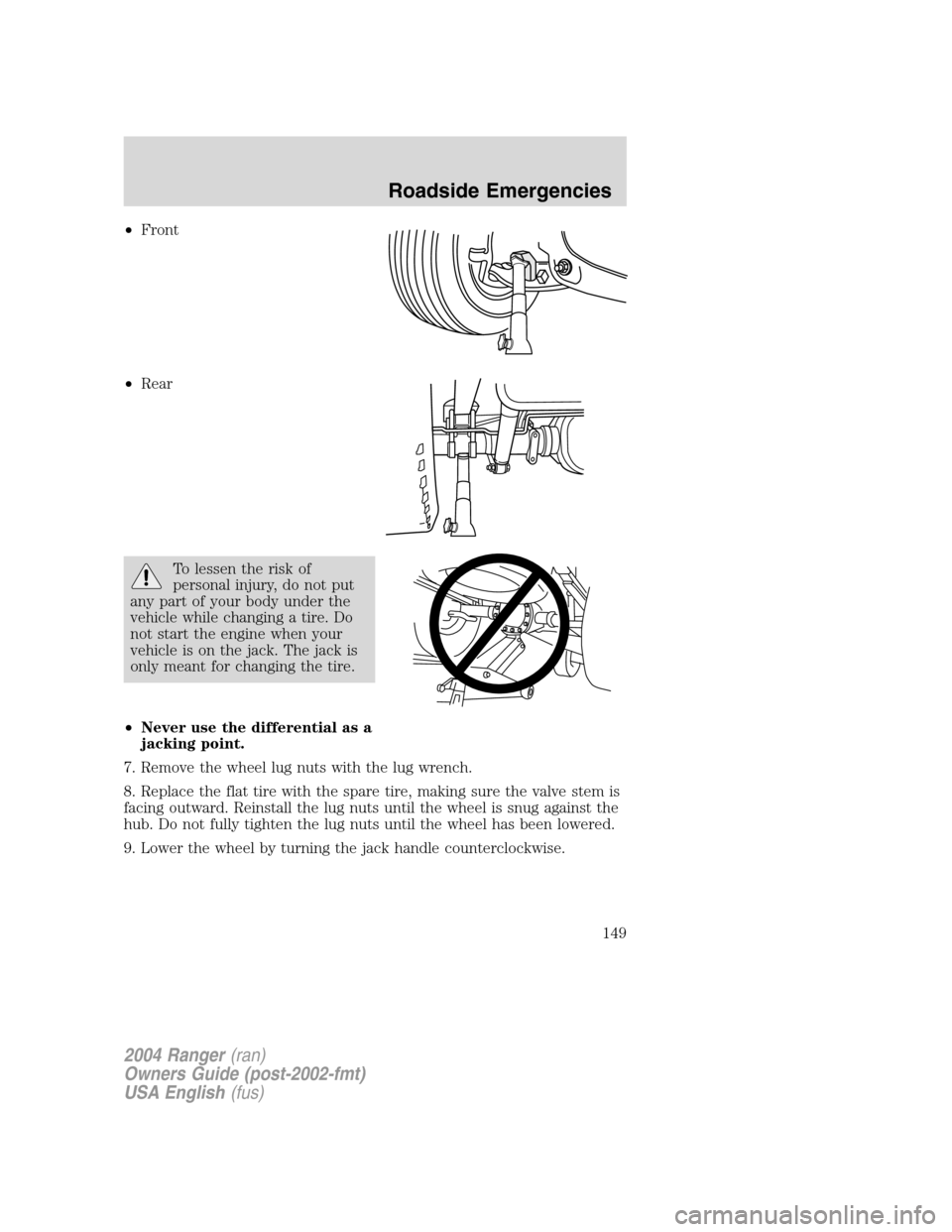
•Front
• Rear
To lessen the risk of
personal injury, do not put
any part of your body under the
vehicle while changing a tire. Do
not start the engine when your
vehicle is on the jack. The jack is
only meant for changing the tire.
• Never use the differential as a
jacking point.
7. Remove the wheel lug nuts with the lug wrench.
8. Replace the flat tire with the spare tire, making sure the valve stem is
facing outward. Reinstall the lug nuts until the wheel is snug against the
hub. Do not fully tighten the lug nuts until the wheel has been lowered.
9. Lower the wheel by turning the jack handle counterclockwise.
2004 Ranger (ran)
Owners Guide (post-2002-fmt)
USA English (fus)
Roadside Emergencies
149
Page 150 of 248
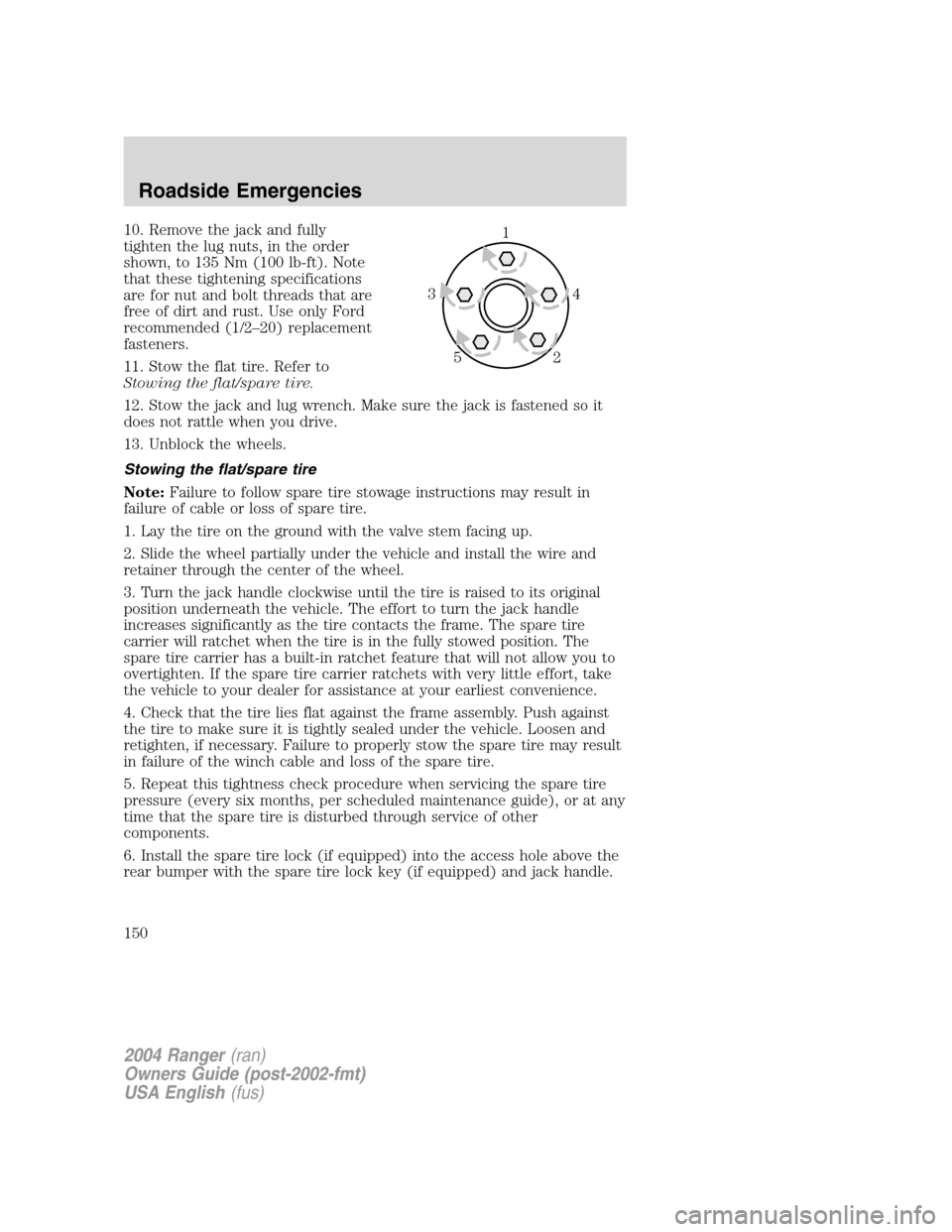
10. Remove the jack and fully
tighten the lug nuts, in the order
shown, to 135 Nm (100 lb-ft). Note
that these tightening specifications
are for nut and bolt threads that are
free of dirt and rust. Use only Ford
recommended (1/2–20) replacement
fasteners.
11. Stow the flat tire. Refer to
Stowing the flat/spare tire.
12. Stow the jack and lug wrench. Make sure the jack is fastened so it
does not rattle when you drive.
13. Unblock the wheels.
Stowing the flat/spare tire
Note: Failure to follow spare tire stowage instructions may result in
failure of cable or loss of spare tire.
1. Lay the tire on the ground with the valve stem facing up.
2. Slide the wheel partially under the vehicle and install the wire and
retainer through the center of the wheel.
3. Turn the jack handle clockwise until the tire is raised to its original
position underneath the vehicle. The effort to turn the jack handle
increases significantly as the tire contacts the frame. The spare tire
carrier will ratchet when the tire is in the fully stowed position. The
spare tire carrier has a built-in ratchet feature that will not allow you to
overtighten. If the spare tire carrier ratchets with very little effort, take
the vehicle to your dealer for assistance at your earliest convenience.
4. Check that the tire lies flat against the frame assembly. Push against
the tire to make sure it is tightly sealed under the vehicle. Loosen and
retighten, if necessary. Failure to properly stow the spare tire may result
in failure of the winch cable and loss of the spare tire.
5. Repeat this tightness check procedure when servicing the spare tire
pressure (every six months, per scheduled maintenance guide), or at any
time that the spare tire is disturbed through service of other
components.
6. Install the spare tire lock (if equipped) into the access hole above the
rear bumper with the spare tire lock key (if equipped) and jack handle.1
4
3
2
5
2004 Ranger (ran)
Owners Guide (post-2002-fmt)
USA English (fus)
Roadside Emergencies
150